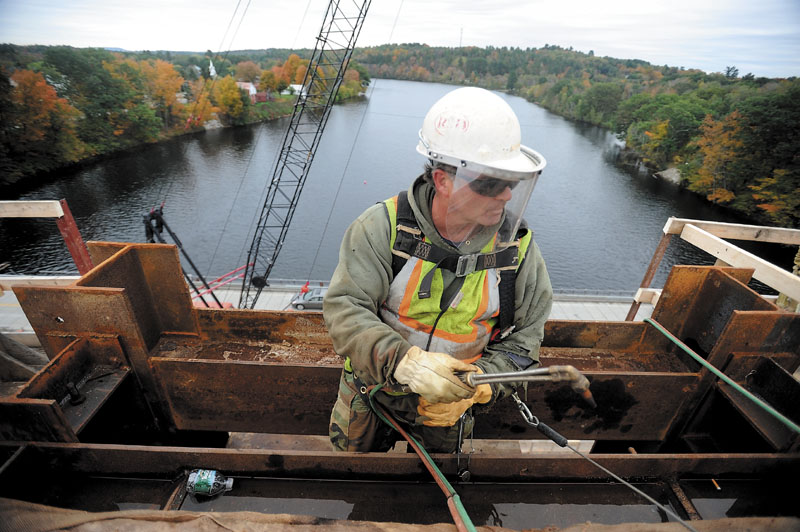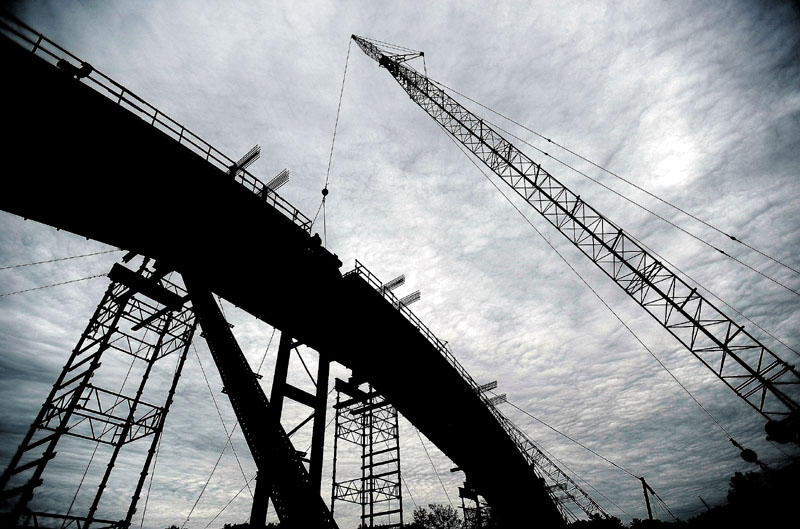NORRIDGEWOCK — When a new, $21 million bridge over the Kennebec River is complete, it will be the second of its design in the United States.
For two years and two months, 30 construction workers, using three cranes, a barge and hundreds of cubic yards of concrete, have been building a bridge that will “maybe put Norridgewock on the map,” said Resident Engineer Catherine Mettey, of the Maine Department of Transportation.
With construction two-thirds complete, the shape of the bridge on U.S. Route 201A, used by 11,000 vehicles each day, is becoming visible. One cement arch has been erected, with one more to go. Most recently, workers from Reed & Reed, in Woolwich, installed a temporary brace to hold the arch in place when other temporary supports are removed.
About 50 percent of the bridge work has been building temporary support systems, Mettey said, as is the nature of building a structure over water. Workers were at the scene for eight months, building the temporary bridge, before they could start on the new bridge.
“You take it one step at a time,” she said.
The project is the longest-running that both Mettey and Senior Technician Mike Pelletier have worked on, and the sequencing of some construction techniques has been new to the two. For example, this bridge requires post-tensioning, where steel strands within hardened concrete are stretched, in order to strengthen the concrete.
“It’s quite an unusual bridge, something to be proud of,” Mettey said.
When construction is finished — the end date is expected to be Oct. 14, 2011, and the schedule is currently on track — the bridge will be twice as wide as the former bridge, with two 12-foot travel lanes, a five-foot sidewalk and a seven-foot multi-use lane. It will be 300 feet long and, at its tallest point, 60 feet high.
Mettey said members of the town and the Maine Historic Preservation Commission wanted the new bridge to resemble the old bridge, which had four arches and opened to traffic in 1928.
The new bridge was designed by Kleinfelder/SEA, with a location in Augusta. A similarly-designed bridge is the Depot Street Bridge in Oregon.
The new structure will be made mostly of concrete, which comes from Mattingly Products Co. in North Anson. The first arch required 240 cubic yards of concrete and took 15 hours to place. It then had to be soaked for a week, so it wouldn’t dry and crumble. Workers brought hoses to the top of the arch and placed burlap over it to hold in the moisture.
So far there have been no injuries at the construction site, Mettey said, although workers did discover some damage to a guardrail near the temporary bridge. She cautioned that people should drive slowly through the construction area. The speed limit is 25 mph.
The previous bridge was not safe, Mettey said, and was unable to handle increased traffic loads. Drivers often were unable to gauge the distance between them and the bridge. One truck went off the embankment; other vehicles struck the bridge.
Town Manager Michelle Flewelling said people are looking forward to the new bridge, especially with its room for foot traffic, ATVs and snowmobiles. “Everybody will have safe passage over the river,” she said.
The project is paid for by the Federal Highway Administration, with some state funds.
Erin Rhoda — 474-9534
erhoda@centralmaine.com
Send questions/comments to the editors.




Success. Please wait for the page to reload. If the page does not reload within 5 seconds, please refresh the page.
Enter your email and password to access comments.
Hi, to comment on stories you must . This profile is in addition to your subscription and website login.
Already have a commenting profile? .
Invalid username/password.
Please check your email to confirm and complete your registration.
Only subscribers are eligible to post comments. Please subscribe or login first for digital access. Here’s why.
Use the form below to reset your password. When you've submitted your account email, we will send an email with a reset code.